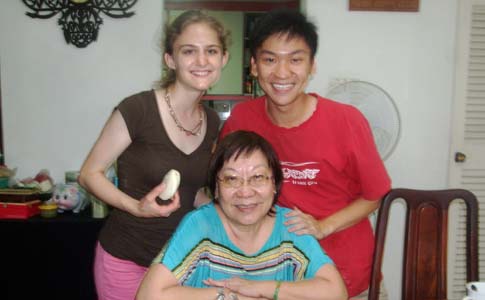Thats What Happens When You Come for Tea, Lah


Emily enjoying tea with her hosts, Isabel Yeo and Alexius Yeo.
That’s What Happens When You Come for Tea, Lah
Before I post numerous accounts of all of the sights and sounds of Singapore, I would be remiss if I did not explain what I am doing here. And what I mean by that is that unlike the other 25 students of the Carolina Southeast Asia program, I am not a first-year student, and I even traveled to Singapore just last year. You see, I completed the SEAS program last summer and liked it so much that I decided to apply again to return as the research fellow.
What could I be researching in Singapore that I couldn’t research in North Carolina, you might ask. Well, many things. Singapore is a tiny, efficient, cosmopolitan country, more closely resembling New York City than the quiet neighborhoods of Chapel Hill. Singapore also has a bustling business industry, best described by the Singaporean word kiasu, which infers a fear of losing and a fiercely competitive edge. And anyone interested in studying the culinary arts would certainly do well to take a few lessons from the cooks behind the Hawker food stalls, creating such delicacies as chicken rice, nasi lemak and laksa. But I am not studying city planning, business, nor cooking in Singapore.
Rather, as a global studies and multimedia journalism double major, I’m more interested in the very people passing me by in the Mass Rapid Transit station, at the Hawker centers, and at Marina Bay Sands. And what better way to learn more about Singaporeans than to construct a research project in which I get the opportunity to ask them personal questions — questions I might not be able to ask without a reporter’s notebook and a recorder.
I rather enjoy meeting new people, and I’ve been known to meet some of my best friends while waiting in line or sitting in a packed auditorium. And since we began our study abroad, I’ve pulled the “I’m new, what’s cool around here?” card, as an excuse to introduce myself, a few too many times. But my research project tops all excuses to get the nitty-gritty details of what makes each person to whom I talk unique.
I’m studying how gender, ethnicity, age and socio-economic status shape and inform Singaporean identity. For my first interview, I spoke with the mother of my friend, Alexius, who earned a joint degree program from the National University of Singapore and our very own UNC. His mother, Isabel Yeo, is a Chinese-Singaporean in her 60s with a knack for being able to talk about everything. She invited me to her home — the first home in Singapore I’d ever visited — for tea.
Upon entering, I was mesmerized by shelf upon shelf of Chinese teapots, each of which appeared to hold no more than a cup of tea. Alexius told me that his father enjoys a three-cup tea ceremony from those tiny teapots twice a day. He and his mother then went on to explain the four-part Chinese tea-brewing ceremony. According to tradition, you don’t drink the first brew, as it’s too potent; instead, you just wash your tea utensils and cups with them so that they assume the tea’s essence. The second brew, which tastes wild and gamy, reminds you of your youth. The third brew is perfect, so you drink it and think of your prime. And by the fourth brew the tea is bitter and alkaline, serving to remind you of your old age and all the things you want to do before